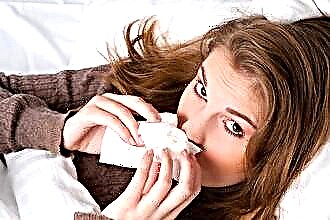Babies are much less likely to get sick in comparison with older children. This is due to less contact with people who can be a source of infection, as well as stronger immune defenses in infants (antibodies circulating in the blood, transmitted from the mother during the prenatal period, and obtained in breast milk). However, despite all the efforts of young parents, a sore throat and cough may still appear in babies. Komarovsky gives on this occasion some advice on the treatment of the disease.
 Note that any change in the infant's behavior, including when specific signs of the disease appear, require the consultation of a pediatrician.
Note that any change in the infant's behavior, including when specific signs of the disease appear, require the consultation of a pediatrician.
Causes of Symptoms
To determine the treatment tactics, you should examine the child, additional diagnostics, and then establish the cause of the development of the disease.
A red throat can be a manifestation of:
- ARVI, which is characterized by rhinorrhea, nasal congestion, lacrimation, subfebrile hyperthermia. In this case, pharyngitis is a symptom or complication of viral infection;
- measles. Promotes an increase in temperature up to 38.5 degrees, the appearance of cough, rhinorrhea and conjunctivitis. Specific spots of a red hue and irregular shape appear on the mucous membrane of the cheeks and the soft palate;
- chickenpox, which is manifested by dyspeptic disorders, fever and rashes in the form of papules and vesicles with a transparent transudate, after opening which crusts form. The disease is characterized by constant dripping, therefore, both crusts and original spots can be found on the body;
- rubella. Transplacentally transmitted from an infected mother. Symptomatically, the disease manifests itself as rhinorrhea, cough, conjunctivitis, lacrimation, itchy skin and rashes in the form of small, red, rounded spots;
- diphtheria. A serious illness characterized by febrile hyperthermia and the appearance of films on the surface of the tonsils, which can spread to the posterior pharyngeal wall and larynx, complicated by asphyxia;
- angina, often of bacterial origin, but fungal is also possible;
- scarlet fever. Manifested by febrile fever, severe intoxication syndrome and rash.
- allergic factors. After exposure to the allergen on the mucous membranes of the nasopharynx / oropharynx, an allergic reaction with pharyngopathy may develop.
- teething, which begins at 4-6 months, can be asymptomatic or provoke sore throat, subfebrile hyperthermia, itching and swelling of the gums.
The appearance of a cough indicates the spread of an infectious-inflammatory process to the larynx, trachea, bronchi, or is a manifestation of an allergic reaction.
Nonspecific symptoms of the disease
 Until the child begins to speak, it is difficult to determine what is bothering him. If you suspect the development of the disease, you should pay attention not only to specific symptoms (rash, cough, runny nose, red throat), but also to general signs. These include:
Until the child begins to speak, it is difficult to determine what is bothering him. If you suspect the development of the disease, you should pay attention not only to specific symptoms (rash, cough, runny nose, red throat), but also to general signs. These include:
- poor appetite or complete refusal to eat. In this case, the baby may refuse to breastfeed. When trying to suck at the breast, the baby develops a sore throat, stops eating and begins to cry. With nasal congestion, the baby does not suckle at the breast, as it cannot breathe, which also provokes crying.
- moodiness indicates the appearance of itchy skin or soreness in the throat, abdomen, or other part of the body;
- lethargy, drowsiness may indicate an increase in temperature;
- refusal to play with toys is also a manifestation of the disease in infants.
Pharyngitis and tonsillitis
Pharyngitis is most often diagnosed in children against the background of a viral disease. Clinically, the disease manifests itself:
- subfebrile hyperthermia;
- lacrimation;
- rhinorrhea, nasal congestion;
- sore throat;
- joint aches;
- capriciousness;
- lethargy;
- loss of appetite.
If the temperature exceeds 38 degrees, the tonsils are edematous, hyperemic and purulent follicles are visualized, tonsillitis should be suspected. Note that there is no runny nose, and closely located lymph nodes are felt by enlarged, edematous and painful.
In infants, against a background of a temperature rise of up to 39 degrees, convulsions, vomiting and confusion may develop.
Local therapy
Features of the treatment of infants are to prohibit the use of throat gargles.
 Often, pediatricians prescribe irrigation with medicinal solutions that have anti-inflammatory, antiseptic and analgesic effects.
Often, pediatricians prescribe irrigation with medicinal solutions that have anti-inflammatory, antiseptic and analgesic effects.
- It is recommended for infants to irrigate not the posterior pharyngeal wall, which can provoke vomiting and laryngospasm, but the mucous membrane of the cheeks or a dummy;
- strict adherence to the dosage and frequency of use of drugs is required;
- lubrication with a gauze swab dipped in a solution allows you to gently sanitize the mucous membrane from pathogenic microorganisms. For the procedure, Miramistin, Furacilin are allowed;
- the use of herbal decoctions (chamomile, calendula, sage);
- resorption of tablet forms of medicines is impossible, therefore, the doctor may recommend crushing a lollipop into powder and mixing with water or lubricating the mucous membrane of the cheeks.
If a baby develops rhinorrhea, mucus can interfere with the feeding process. To prevent this, you must:
- cleansing the nasal cavities with saline solutions, for example, saline, Aqua Maris, as well as antiseptics (Furacilin, Miramistin). You can also use a small concentration of chamomile decoction;
- in the form of drops, you can use antiviral, for example, Nazoferon;
- homeopathic medicines, for example, Delufen has anti-inflammatory, decongestant, anti-allergic and antiseptic effects;
- vasoconstrictor drugs, such as Otrivin, Vibrocil, help eliminate edema of the mucous membrane by reducing the release of the liquid part from the bloodstream, and also reduce the production of mucous secretions.
Fighting cough
In the treatment of cough, the following medicines can be used in the form of a suspension and drops:
- antitussives (Sinekod - from two months, Panatus - from six months). Allow to reduce the cough reflex, to overcome paroxysmal dry cough, is used most often for whooping cough. Dosages are selected taking into account body weight.
 mucolytics (Ambrobene, Lazolvan) help to reduce the viscosity of sputum, improve the drainage function of the bronchi and stimulate the excretion of sputum;
mucolytics (Ambrobene, Lazolvan) help to reduce the viscosity of sputum, improve the drainage function of the bronchi and stimulate the excretion of sputum;- expectorants with ivy and plantain, for example, Prospan, Bronchicum.
If the cough persists and the fever intensifies, inflammation of the lung tissue should be suspected.
Treatment of pneumonia is carried out exclusively in a hospital under the round-the-clock supervision of a doctor. The clinic has everything you need for emergency care with an increase in respiratory failure.
General recommendations
Depending on the pathogenic pathogens, the following are prescribed:
- antiviral drugs, for example, Viferon in the form of suppositories, which allows you to overcome a viral infection and increase the body's immune defenses. The medicine is prescribed only for the viral origin of the disease;
- antibacterial drugs, for example, Amoxiclav, is taken for tonsillitis and other bacterial diseases;
- antipyretic drugs such as Panadol, Nurofen in the form of a suspension, Efferalgan in suppositories;
- breastfeeding does not stop despite the baby's decreased appetite.Breast milk has beneficial antibodies needed to strengthen immunity;
- do not dress children very warmly, as increased sweating will increase fluid losses, which will lead to dehydration and drying out of the mucous membranes;
- humidifying the air, regular wet cleaning and airing the room;
- strengthening of immunity with the help of Lifomyosot, Tonsipret. The drugs are used for otolaryngological diseases.
When the first symptoms of diseases appear, you should consult a doctor for examination and determination of treatment tactics. The treatment course can be carried out at home or requires hospitalization of the child. It depends on the severity of the pathology, the presence of concomitant diseases and the developmental characteristics of the child.

 mucolytics (Ambrobene, Lazolvan) help to reduce the viscosity of sputum, improve the drainage function of the bronchi and stimulate the excretion of sputum;
mucolytics (Ambrobene, Lazolvan) help to reduce the viscosity of sputum, improve the drainage function of the bronchi and stimulate the excretion of sputum;

